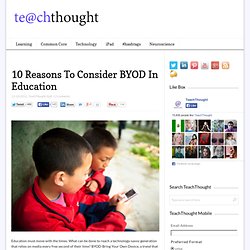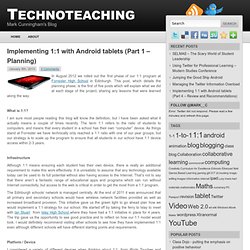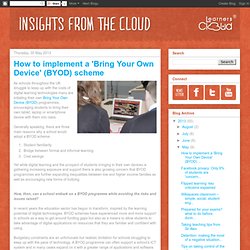

Choose a Showcase - eLearning ICT - DEECD. 10 Reasons To Consider BYOD In Education. Education must move with the times.

What can be done to reach a technology-savvy generation that relies on media every free second of their time? BYOD-Bring Your Own Device, a trend that is catching on quickly. Bring Your Own Device has transformed the classroom by creating new opportunities for learning. Studies find that Generation Y is highly reliant on wireless devices and phones.
And rather than fight it, educators can use this to their advantage. In Millennians: A Portrait of the Next Generation, the researchers found that most of Generation Y prefers to connect wirelessly (81%) and the majority use social networking to connect with others (73%). Why Does BYOD Makes Sense For Educators? 1. 2. 3. 4. A free application called Studyboost, allows students to receive study questions via text. Kindle, Wikipedia, and Google books offer a list of free textbooks that students can access in the classroom. 5. 6. 7. 8. 9. 10. Should Educators Jump On The BYOD Bandwagon? OPINION. Implementing 1:1 with Android devices (Part 1 – Planning) In August 2012 we rolled out the first phase of our 1:1 program at Forrester High School in Edinburgh.

This post, which details the planning phase, is the first of five posts which will explain what we did at each stage of the project, sharing any lessons that were learned along the way. What is 1:1? I am sure most people reading this blog will know the definition, but I have been asked what it actually means a couple of times recently. The term 1:1 refers to the ratio of students to computers, and means that every student in a school has their own “computer” device. As things stand at Forrester we have technically only reached a 1:1 ratio with one of our year groups, but our strategy is to scale up the program to ensure that all students in our school have 1:1 device access within 2-3 years. Infrastructure Although 1:1 means ensuring each student has their own device, there is really an additional requirement to make this work effectively. Platform / Device Funding Cohort from your own site. How tablets are invading the classroom. LearnersCloud Blog: How to implement a 'Bring Your Own Device' (BYOD) scheme.
As schools throughout the UK struggle to keep up with the costs of digital learning technologies many are initiating their own Bring Your Own Device (BYOD) programmes, encouraging students to bring their own tablet, laptop or smartphone device with them into class.

Generally speaking, there are three main reasons why a school would adopt a BYOD scheme: Student familiarityBridge between formal and informal learningCost savings Yet while digital learning and the prospect of students bringing in their own devices is gathering increasing exposure and support there is also growing concern that BYOD programmes are further expanding inequalities between low and higher income families as well as encouraging new forms of bullying. How, then, can a school embark on a BYOD programme while avoiding the risks and issues raised? In recent years the education sector has begun to transform, inspired by the learning potential of digital technologies. What are the risks? Managing a BYOD scheme Author.